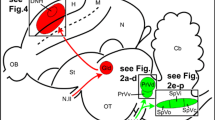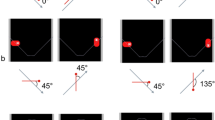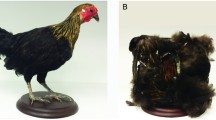Abstract
Chickens are precocial birds, capable of moving independently from within a few hours of hatching, and thus provide a useful model to investigate the development of magnetoreception in young birds. Chicks show some sharply-timed behavioural changes at around 11 days of age that may be indicative of improvements in navigation ability around this age. We trained Young (<10 days, n = 7) and Old (11 days or older, n = 6) chicks to find a hidden imprinting stimulus behind one of four screens in a square arena. Once criterion was reached, the directional choices of chicks were recorded in unrewarded tests in the geomagnetic field and in an experimental field shifted by 90° clockwise. These tests were separated with rewarded training trials to avoid extinction. In the first, and the first 3 tests, no indication was found that chicks chose the correct unimodal magnetic direction. Instead, in all tests, Old chicks preferred the screens in the same magnetic axis as the training direction in tests in the geomagnetic and shifted experimental fields significantly more than Young chicks (P < 0.05). Choices of Young chicks were no different to chance in tests, whereas choices by Old chicks were significantly different from chance (P < 0.05). Our findings support the hypothesis that magnetoreception appears in the second week of life in the chicken. It is, however, unclear when a truly directional magnetic response (i.e. an unimodal, rather than axial, response in our test) develops that could be used by the chicks for accurate navigation.


Similar content being viewed by others
References
Colombo M, Broadbent N (2000) Is the avian hippocampus a functional homologue of the mammalian hippocampus. Neurosci Biobehav Rev 24:465–484
Denzau S, Nießner C, Rogers LJ, Wiltschko W (2013) Ontogenetic development of magnetic orientation in domestic chickens (Gallus gallus). J Exp Biol 216:3143–3147
Freire R (2011) Ethical advantages of using domestic bird species for magnetic orientation research. Commun Int Biol 4:1–2
Freire R, Rogers LJ (2005) Experience-induced modulation of the use of spatial information in the domestic chick. Anim Behav 69:1093–1100
Freire R, Rogers LJ (2007) Experience during a period of right hemispheric dominance alters attention to spatial information in the domestic chick. Anim Behav 74:413–418
Freire R, Cheng H-W, Nicol CJ (2004) Development of spatial memory in occlusion-experienced domestic chicks. Anim Behav 67:141–150
Freire R, Munro U, Rogers LJ, Wiltschko R, Wiltschko W (2005) Chicken orient using the magnetic compass. Curr Biol 15:620–621
Gunnarsson S, Yngvesson J, Keeling LJ, Forkman B (2000) Rearing without early access to perches impairs the spatial skills of laying hens. Appl Anim Behav Sci 67:217–228
Morris HM (2009) Effects of early rearing environment on learning and behaviour in laying hens. MSc dissertation, Oregon State University, Oregon
Munro U, Munro JA, Wiltscko W (1997) Evidence of a magnetite-based navigational “map” in birds. Naturwissenschaften 84:26–28
Rashid N, Andrew RJ (1989) Right hemisphere advantage for topographical orientation in the domestic chick. Neuropsychologia 27:937–948
Regolin L, Garzotto B, Rugani R, Pagni P, Vallortigara G (2005) Working memory in the chick: parallel and lateralized mechanisms for encoding of object- and position-specific information. Behav Brain Res 157:1–9
Rogers LJ (1995) The development of brain and behaviour in the chicken. CAB International, Wallingford
Rogers LJ, Ehrlich D (1983) Asymmetry in the chicken forebrain during development and a possible involvement of the supraoptic decussation. Neurosci Lett 37:123–127
Rogers LJ, Munro U, Freire R, Wiltschko R, Wiltschko W (2008) Lateralized response of chicks to magnetic cues. Behav Brain Res 186:66–71
Tommasi L, Gagliardo A, Andrew RJ, Vallortigara G (2003) Separate processing mechanisms for encoding of geometric and landmark information in the avian hippocampus. Eur J Neurosci 17:1695–1702
Vallortigara G, Regolin L (2002) Facing an obstacle: lateralization of object and spatial cognition. In: Andrew RJ, Rogers LJ (eds) Comparative vertebrate lateralization. Cambridge University Press, Cambridge, pp 383–444
Vallortigara G, Andrew RJ, Sertoli L, Regolin L (1997) Sharply timed behavioural changes during the first 5 weeks of life in the domestic chicken (Gallus gallus). Bird Behav 12:29–40
Wichman A, Heikkila M, Valros A, Forkman B, Keeling L (2007) Perching behaviour in chickens and its relation to spatial ability. Appl Anim Behav Sci 105:165–179
Wichman A, Rogers LJ, Freire R (2009) Visual lateralisation and development of spatial and social spacing behaviour of chicks (Gallus gallus domesticus). Behav Processes 81:14–19
Wiltschko W, Wiltschko R (1995) Magnetic orientation in animals. Springer, Berlin
Wiltschko W, Freire R, Munro U, Ritz T, Rogers LJ, Thalau P, Wiltschko R (2007) The magnetic compass of domestic chicken, Gallus gallus. J Exp Biol 210:2300–2310
Wilzeck C, Wiltschko W, Güntürkün O, Wiltschko R, Prior H (2010) Lateralization of magnetic compass orientation in pigeons. J R Soc Interface 7:S235–S240
Witelson SF (1976) Sex and the single hemisphere: specialization of the right hemisphere for spatial processing. Science 193:425–427
Acknowledgments
We would like to thank the anonymous reviewers and associate editor for helpful suggestions on the text and figures.
Author information
Authors and Affiliations
Corresponding author
About this article
Cite this article
Munro, U., Luu, P., DeFilippis, L. et al. Ontogeny of magnetoreception in chickens (Gallus gallus domesticus). J Ethol 32, 69–74 (2014). https://doi.org/10.1007/s10164-014-0395-3
Received:
Accepted:
Published:
Issue Date:
DOI: https://doi.org/10.1007/s10164-014-0395-3




